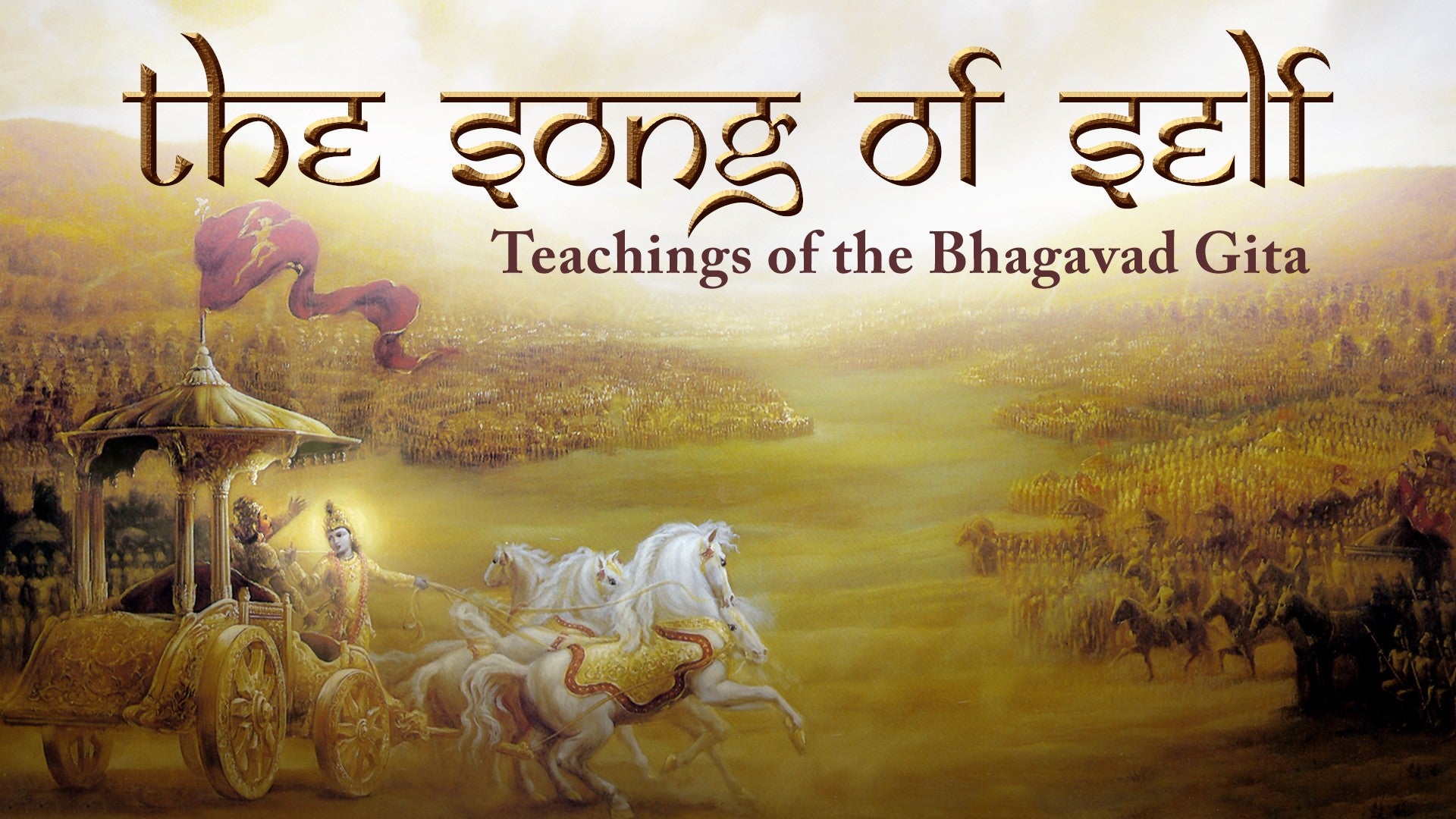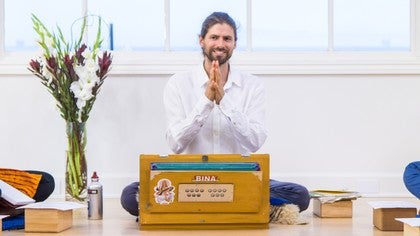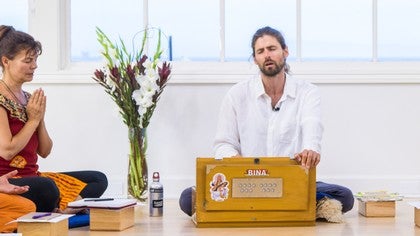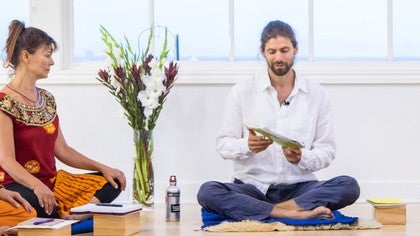Description
About This Video
Transcript
Read Full Transcript
So greetings everyone and welcome. So we're now going to begin our exploration of the second chapter of the Bhagavad Gita. And I always feel very privileged when we start with the second chapter of the Gita. As the Bhagavad Gita of all the teachings of yoga, it's one of these texts that's particularly treasured. So in the yoga universe, in the realm of yoga teachings, there are so many texts, so many different practices, and various lineages and traditions, but all the lineages and traditions that I've been exposed to, they all really treasure the Bhagavad Gita.
And I hope this will become clear why if we get into the text. And the Gita has a number of distinguishing features, and one of the things that's really quite remarkable is its setting. So when I first started getting into yoga, I thought, well, isn't yoga all about peace? And then I open up a translation of this text, the Bhagavad Gita, which my teacher had said this is just the absolute epitome of yoga. It's a beautiful text, very concise, full of wisdom.
And I open to the first chapter, and I find a list of names on the battlefield. And I thought, what's going on here? I didn't really understand, but very fortunately for me, just shortly after that, I was able to attend a class with one of my teachers, and he presented the text from within the tradition, and then it became apparent that there were many significant and helpful reasons why the setting was so dramatic. So first of all, there is this whole aspect of the drama. So you can imagine if you go to see a play, or you go to the cinema, and the story builds to a climax, and there's something very dramatic has been building, where do you start to sit in the movie theater or in the theater?
You sit on the edge of your seat, we might say. So in the Gita, it's actually part of this much bigger text called the Mahabharata. And the Mahabharata is one of the great epics of the Indian tradition. And they actually say about Mahabharata, if you can't find it in the Mahabharata text, you won't find it in life. And if you find it in life, you'll be able to find it in this text, it's so vast.
But in the middle of this text is interwoven, this beautiful 700 verses of the Bhagavad Gita. Now, Gita means song. And Bhagavan basically means one who is a total master. And so it refers to the teacher in the Gita, Krishna, who we might also refer to as God, or the Lord, or the Supreme, or the Master. But basically Bhagavan is one who has come to a total understanding of his or her capacities and his or her essence.
And so the teacher, Bhagavan, gives the teaching in the form of a song. Now, if we think of a song, a beautiful song is something that carries harmony, it's harmonious. And so one way I think of the Gita is it's teaching us how to be in harmony, even in the middle of life, which can sometimes involve difficult challenges and conflict. And this setting on the battlefield, the question I really was invited to ask myself when I first listened to the Gita being described and explained by a teacher from within the yoga tradition was, have I ever done anything that was not in my own highest interest? Is there ever a day goes by when any human being doesn't do something that is not in his or her highest interest?
And so is the idea that there must actually be some type of battle going on inside. Because if there wasn't, we'd never do anything that wasn't really serving us, that wasn't really responding to our deeper needs and our deeper longings. And yet we do. We do sometimes stray into these patterns of self-sabotage. And hence the setting reminds us that this is part of life, but it's not a barrier to yoga.
And this is another beautiful thing about the setting being on the battlefield. Sometimes in life, you might find you're going along with a yoga practice and everything's kind of easy. But then life gets a bit more demanding and you think, I just don't have time for yoga. And you might say, oh, well, it's all right for those people who don't have a job or don't have seven children or don't have to worry about how they're going to make the next mortgage payment. I say, oh, I'll get to yoga when I have time.
But the setting of the Gita reminds us that there is no situation too extreme for yoga. No situation is a barrier to yoga. And actually, when situations are more challenging, as we'll discover, this is actually a greater opportunity for yoga. Because when we're challenged, when we're facing something that's really putting us into a position that we're not so comfortable, it almost obliges us and invites us to draw on deeper resources and access more of what we're really made of. And so this dramatic setting is that reminder that wherever we find ourselves, yoga is accessible right there.
Because really, all yoga is about, is about being here now, totally, with every part of ourselves. And so the Bhagavad Gita, the song of the Lord, or the song of mastery, one of the ideas the title carries is that when we give ourselves permission to fully inhabit this present moment with every part of ourselves, then we're actually going to discover more of our true capacity. So when we study the Gita, it doesn't matter what's going on in our life. Generally, the Gita is going to offer us some insight, some support. And this is one of the beautiful things with this text.
When I was introduced to the Bhagavad Gita and also other yoga texts like the Yoga Sutras, it was kind of emphasized to me that this isn't the type of text that you get for Christmas or your birthday, read it, and then just give it away to your friend. It's not that you read it and then you're done with it. The idea is that every single verse, every single syllable really, is an invitation for contemplation, for reflection, and for meditation. So to study the Gita doesn't just mean to read it through, or to recite it, or to even learn the verses by heart. It means to study it so that it's actually in you.
So this was also emphasized when I first started studying the text with my Sanskrit teacher in India. And I had this copy here, and you can see this rather well-thumbed copy of the Bhagavad Gita text, and I was studying with my Sanskrit teacher in Mysore, South India, and he's part of a kind of family lineage of what they call acharyas in the South Indian tradition, and it basically means that an acharya is one who basically, his responsibility is to embody and give guidance to others about how to behave in the world and how to manage all the different responsibilities that they face, while also cultivating harmony. And they've been Sanskrit teachers as well, father to son, for many generations, and I was studying with the son, Alwa, who at that time was in his, maybe, very late thirties or early forties, and we'd just begun after, we'd been studying for a few days, we'd just done just a few verses, and I arrived at the house, and Alwa, my teacher, opened the door and he says, oh, today, father will take the class. And at this time, his father, Lakshmitathacharya, was 74 years old, and he's been teaching Sanskrit for, I don't know how long, and so I was feeling quite privileged that, you know, this great seasoned teacher was going to spend some time with me, and so he asked me, he says, James, what have you been doing? So I said, oh, we're doing Gita, second chapter, and he says, how far have you got?
I've done eight verses, very good, recite them, and so I recite them, and then he's not entirely satisfied, and then he spends basically two hours with me, just doing these eight verses, and he's reciting and I'm repeating, he says, look at my mouth, and then when he's satisfied, more or less, he then says, it's good you're studying the Gita, James, but I'd like you to really study it, don't study it like you've learned what study means in the West, he said, because in India, they imported this British education system, he says, I don't understand it, you have these exams, and you know the exam date, and you even know the exam time, and you even know more or less what they're going to ask you in the exam, because you have sample papers, you say, what type of test is that? This is a real exam, is when you don't know when you're going to be asked the question, or what the question's going to be. So you can fall into this trap that thinking study means learning it so you can replicate it in exam conditions, but those exam conditions are no real examination, because I would like you to learn this text so you actually know it, know it really by heart, which doesn't mean knowing it so you can repeat the verses in a rote way, but it's so deep inside you, it's like it's in your very cells. So when the wisdom in this text can help you, you can draw on it right away, without any hesitation, and then he gave the example, he said, just like you're on your computer, you upload some software, let's say you upload a Sanskrit English dictionary, and if you need to use it, you can just click on the icon and the dictionary pops up, and you can use it right away. Let it be like that, put the Gita into your very cells, and then when it's in your cells, and you know it by heart, and you can look into it, and it can guide you, as it needs to appropriately in that moment, then you can pass the book on to somebody else.
But read it like that, it's a book we can keep looking into. So one way that my teacher described the Gita and the Yoga Sutras is as miracle mirror texts. The idea, you can look into them, and every time you look into them, they will show you something fresh, they'll show you something new, they'll invite new insight, if you look into them sincerely. And so as we get into the verses, we're going to explore the text as we go along, today, as we're doing it. But one beautiful thing with the Gita, we can revisit it, and it can show us new things.
So as we go through the verses, I'd invite you to think about, yeah, how can I explore this in my day-to-day? And if there's a particular verse or a particular teaching that really resonates, I'd invite you in your own practice, in your day-to-day life, think about, yeah, how can I explore this? And this is how we can really start to study the Gita and start to create that personal relationship with it. It can become part of our life, part of our practice, and then hopefully be a support to invite more of that harmonizing, integrating power of yoga into our day-to-day. So wherever we find ourselves in our day-to-day, the Gita can be a support.
So in a few moments, we're going to start getting into the background of the text and then getting into the verses itself. But before we do that, I'd just like to kind of reaffirm the invitation. Anytime you want to look into the Gita, if you look into it with a clear mind and an open heart, it can show you so much. So we're going to explore this text together, and there's a group of us who are going to be kind of exploring together, so I'd just like to introduce you. So I'm James, and this is Matt, Julia, Alana, Mihalya, Christina, and Kelly.
And so sitting together is going to help us kind of bring more out of the verses. And this is something I'd also invite you to do if you're working with this at home. Maybe sometimes you might have to watch in a small group or with a friend. And whenever that happens, when there's two or three or a small group of you exploring a verse together, often it brings out more. So not only can you revisit it personally, but you can revisit it with your friends or with different people.
And then maybe more and more things will come out through these verses. So shortly we'll get underway, so thank you, and I'm excited to dive in deeper.







You need to be a subscriber to post a comment.
Please Log In or Create an Account to start your free trial.